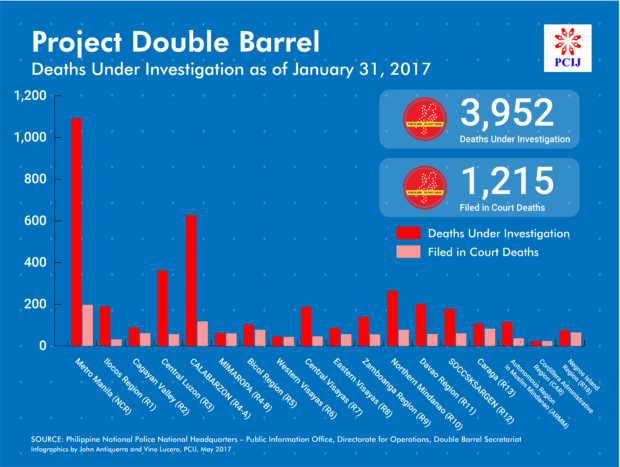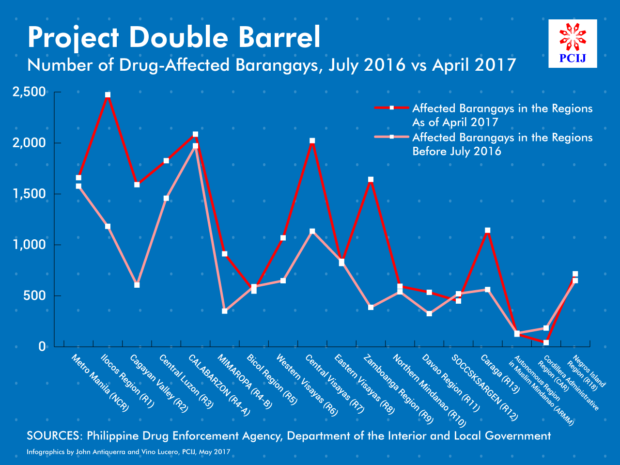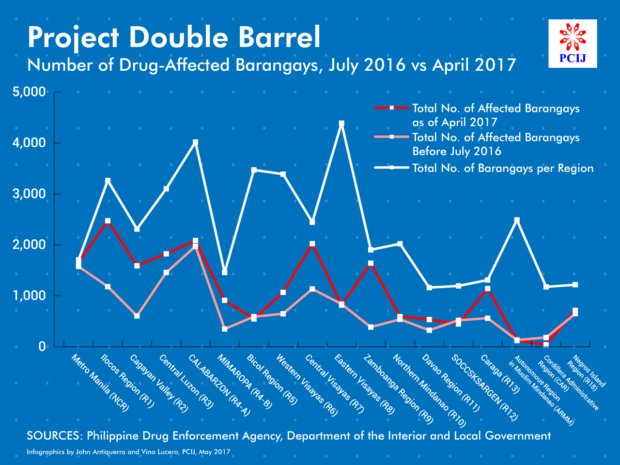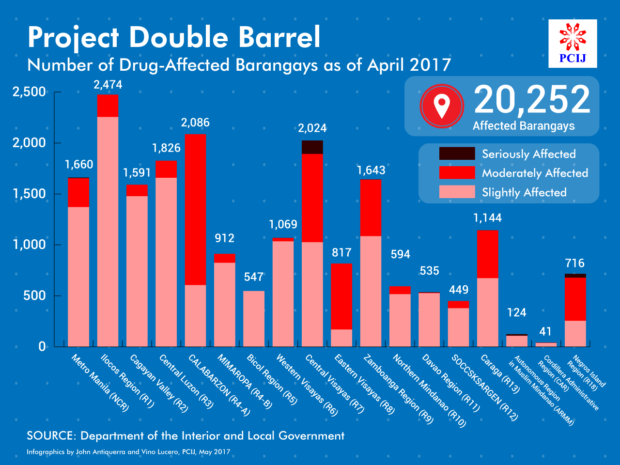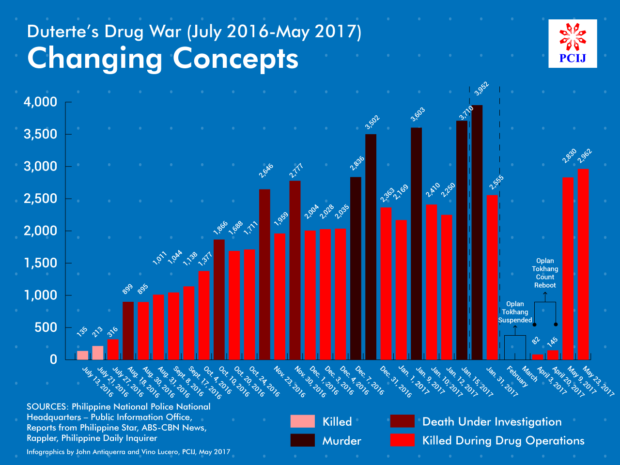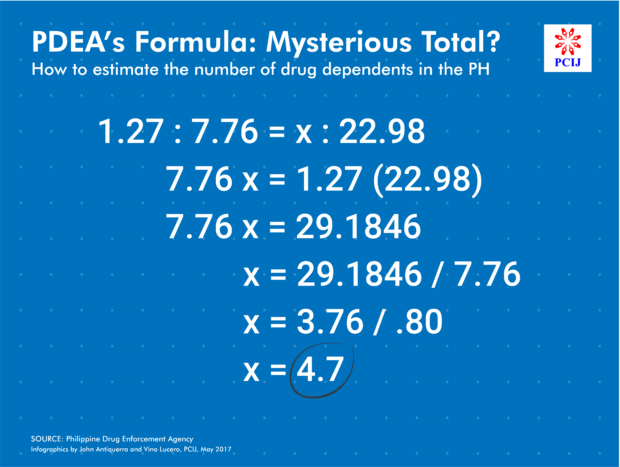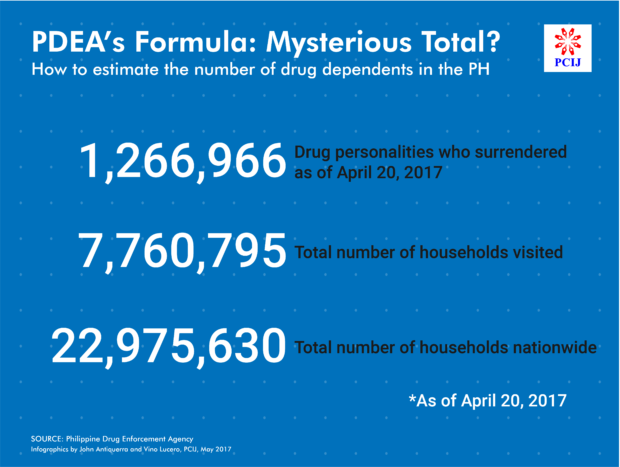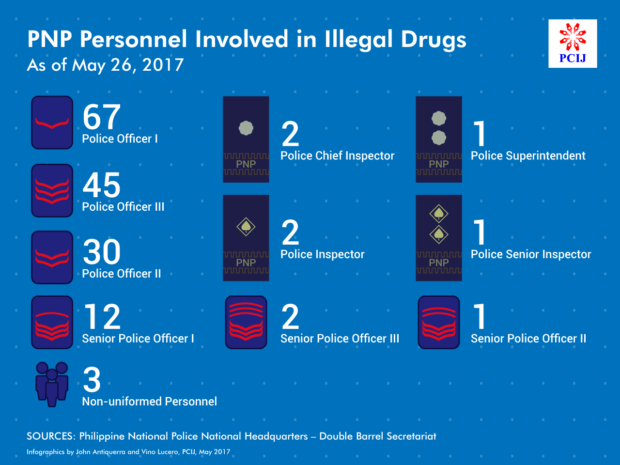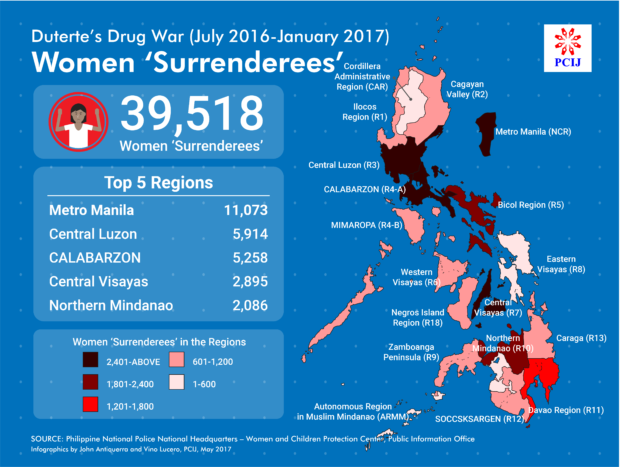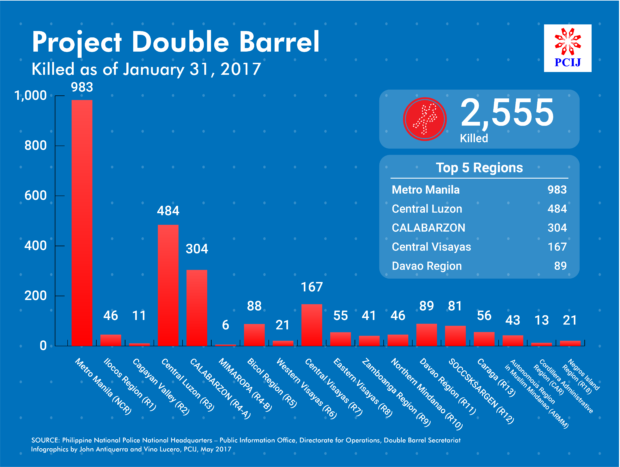#RealNumbersPH unreal, inexact, locked in riddles — PCIJ
IT HAS been branded to be the true, the good, if not so beautiful, official report on the war on drugs of the Duterte administration over the last 11 months.
Launched last May 2, #RealNumbersPH is now the government’s unitary report on the virulent drug war of the Inter-Agency Committee on Illegal Drugs or ICAD, which was created only last March 6 as a task force with representatives from 20 law-enforcement and other state agencies.
Every Friday since, the Philippine National Police (PNP), the Philippine Drug Enforcement Agency (PDEA), and other ICAD agencies have been obliged to submit updated reports to the Presidential Communications Operations Office (PCOO) and the Office of the President (OP). These are then consolidated into #RealNumbersPH, which in turn is transformed into social cards that run weekly on Mondays in the government-run Philippine News Agency, and on the social media pages of the PCOO and ICAD agencies.
Five editions of #RealNumbersPH have been released so far — on May 2, May 9, May 15, May 23, and May 30, 2017, with varying datasets featured.
By all indications, from a largely police operation in its first 10 months, the war on drugs has turned also into a PR and publicity operation for the Duterte administration.
Last month, in fact, representatives of the ICAD agencies were called to a communication-planning workshop organized by the OP and PCOO.
Article continues after this advertisementBut PCIJ’s review of the data enrolled in #RealNumbersPH against official source documents of the PNP, PDEA, Dangerous Drugs Board (DDB), and Department of Health, among other ICAD agencies, unmasks #RealNumbersPH to be real, correct, and true only mostly by name.
Article continues after this advertisementIn particular, the first, fourth and fifth editions of #RealNumbersPH are writ in riddles and feature flawed and inflated numbers that are wildly different from what the primary drug-war data source, the PNP, had reported on the same dates or for the same covered periods.
Too, some of the numbers enrolled in #RealNumbersPH paint a picture so incredibly bloody, or simply incredible.
It reported that in 11 months from July 1, 2016 to May 30, 2017, homicide cases in the country had 12,426 — or 1,129 a month or 37 cases a day. It also says that this total includes 2,091 drug-related cases; 2,447 not drug-related; and 7,888 cases with motive not yet determined.
The figure is fantastic in itself because according to the PNP’s Crime Outlook Report, the annual total homicide cases in the country has been far less than that in the last few years: 7,007 in 2013; 3,349 in 2014; 2,835 in 2015; and 2,338 in 2016.
#RealNumbersPH’s tally of homicide cases in the last 11 months is even higher by almost 70 percent than the sum of homicide cases recorded by the PNP from 2014 to 2016, which was 8,552.
Yet, of course, #RealNumbersPH’s number for homicide cases crossed the second half of 2016 (July to December) and the first five months of 2017 (January to May).
Still, since the total homicide cases recorded in 2016 was only 2,338, it would appear that the balance of 10,088 homicide cases in #RealNumbersPH’s latest report must have occurred only from Jan. 1 to May 30, 2017 — an average of 2,017 cases monthly, or 67 cases daily, or nearly three cases per hour.
More inexact numbers spill out of #RealNumbersPH’s reports, however.
For instance, in its fourth report discussed in a PNA story dated May 26, #RealNumbersPH had figures that were wildly different from what the primary drug-war data source, the PNP, had reported on the same date, or for the same covered period. According to #RealNumbersPH, from July 2016 to May 23, 2017
3,027 had been killed in drug operations. That would be 25 to 65 more persons killed compared with data as of the same date, May 23, 2017, from the PNP Directorate for Operations and PNP Double Barrel Secretariat;
59,364 anti-drug operations conducted, or 3,883 to 4,059 more operations than the data from the two PNP offices;
78,804 suspects arrested or 3,126 to 6,012 more suspects arrested than the data from the PNP offices; and
1,286,389 surrenderees, or 83,343 more surrenderees than the data from the PNP Directorate for Operations.
On the bigger number of operations launched that #RealNumbersPH reported, it must be noted that apart from PNP units, the PDEA, the National Bureau of Investigation and a composite Armed Forces unit have also been authorized to conduct anti-illegal drug operations.
However, with PDEA having only 1,786 plantilla and non-plantilla personnel, and the NBI 1,826, it would seem impossible for them to account for nearly 4,000 more operations conducted, up to 65 more persons killed, up to 6,000 more persons arrested, and over 83,000 more persons coaxed to surrender, all in a day last May 23 — that is, if #RealNumbersPH’s fourth report got its numbers right, and the PNP got its numbers wrong.
Meanwhile, in its fifth report released this Sunday, June 4, #RealNumbersPH did not have a total tally of “PNP personnel allegedly positive for use of illegal drugs” from July 1, 2016 to May 30, 2017. Instead, it merely said that according to the PNP Internal Affairs Service (IAS), only 207 cases of PNP personnel allegedly positive for illegal-drug use had been investigated. Its social card also showed that 158 cases had been “resolved” (and those involved “recommended dismissed from service), and also that 158 PNP personnel had been dismissed. It is unclear, though, whether or not the 158 involved in the “resolved” cases and those dismissed were the same individuals.
But the picture gets even murkier despite #RealNumbersPH’s social-card graphics. Even though it already said that more than 100 PNP personnel had been allegedly involved in drugs, #RealNumbersPH reported that of the 280 “government workers arrested in anti-illegal drug operations” during the same period, only 23 were “uniformed personnel.”
These numbers are also mere fractions of the data obtained by PCIJ from official PNP sources:
Asked for data on the status of the PNP’s “internal cleansing” drive that forms part of Project Double Barrel, the PNP-IAS sent PCIJ reports on the “Status of Administrative Cases” and “Recommended Penalty of Resolved Administrative Cases.” These reports showed that from July 2016 to April 2017, a total of 203 PNP personnel had been dismissed from the service, 131 suspended, 49 demoted, nine issued reprimand, 159 exonerated, and 384 cases dismissed.
As of May 26, 2017, a total of 166 PNP personnel on the numbers of “PNP personnel involved in illegal drugs” in 2016 had been dismissed from the service, according to the PNP Directorate for Operations. They include 158 PNP personnel from regional offices and national support units, and only eight from national headquarters. Of the 166, the big clusters have ranks of PO1 (67 personnel), P03 (45), P02 (30), and SP01 (12). In addition, there are also one police superintendent, two chief inspectors, one senior inspector, two inspectors, two SPO3, one SPO2, and three non-uniformed personnel.
The 166 total PNP personnel “found to be involved in illegal drugs,” according to the PNP’s Directorate for Operations is easily seven times more than #RealNumbersPH’s count of 23 PNP personnel arrested in drug operations.
The difference is significant: 166 minus 23 is 143 PNP personnel involved in illegal drugs who somehow went missing in the #RealNumbersPH count. One explanation could be that #RealNumbersPH may have wanted to report a deflated tally. It is also possible that the PNP knows that many more of its personnel are involved in illegal drugs but had yet to arrest them as of May 26, 2017.
What seems apparent in #RealNumbersPH’s first to the fifth reports between May 2 and May 30, 2017, however, is a deceleration of the growth rate of the numbers of those arrested, killed, or had surrendered, as well as the number of PNP’s drug operations.
Interestingly, what has suddenly disappeared in the government’s latest series of reports on the drug war is the number of houses visited under Oplan Tokhang. Logged at 7,760,795 as of May 9, this dipped to 7,189,306 as of May 23, in reports of the PNP Double Barrel Secretariat and PNP Directorate for Operations. But since its birth last May 2, #RealNumbersPH has not made any references to houses visited, a number that still appears in the respective reports of these two PNP offices.
Here are other time-series numbers, and their unusual slipping and sliding values, from #RealNumbersPH:
ALLEGED DRUG USERS AND PUSHERS KILLED:
2,692, as of April 20, 2017;
2,949 as of May 9, 2017;
3,027 as of May 23, 2017 (PNA article); and
3,050 as of May 30, 2017.
PCIJ Note: In its first to fourth entries on “killed drug personalities,” as of May 23, 2017, #RealNumbersPH reported an increase of 335 cases of persons killed in four weeks, or 85 killed on average a week. In the fifth report, it showed an increase of only 23 persons killed in a week’s time.
ALLEGED DRUG USERS AND PUSHERS ARRESTED:
64,917 as of April 20;
72,812 as of May 9;
78,804 as of May 23; and
80,415 as of May 30.
PCIJ Note: In its first to fourth reports, as of May 23, 2017, #RealNumbersPH reported an increase of 13,887 persons arrested, or 3,471 on average weekly. In the fifth report, it showed an increase of only 1,611 alleged drug users arrested in a week’s time.
ALLEGED DRUG USERS AND PUSHERS WHO “SURRENDERED”:
1,266,966 as of April 20;
1,266,966 as of May 9;
1,286,389 as of May 23; and
1,288,140 as of May 30.
PCIJ Note: A document that PDEA furnished PCIJ showed that as of May 15, 2017, the total number of surrenderees was also 1,266,966, or the same number enrolled in #RealNumbersPH data in its first and second reports.
#RealNumbersPH on May 2 and May 9 listed the same number of alleged surrenderees: 1,266,966. In its fourth report, it recorded an increase of 19,423 “surrenderees” in two weeks‘ time, or 9,711 weekly. In its fifth report, it recorded an increase of only 1,611 surrenderees in a week’s time.
PNP reports obtained by PCIJ also showed the numbers flipping back to ground level amid the relaunch last March of the drug war into Project Double Barrel Reloaded.
The PNP gave two figures. The PNP-Public Information Office reported that only 85,850 persons had surrendered from March 1 to April 20, while the PNP Directorate for Operations said that only 18,274 had surrendered from March 1 to May 9, 2017.
POLICE ANTI-DRUG OPERATIONS:
53,503 as of April 20;
57,554 as of May 9;
59,364 as of May 23; and
60,395 as of May 30.
PCIJ Note: Summary data that PDEA gave PCIJ showed that a total of 57,892 operations against illegal drugs had been conducted as of May 15. In its first to fourth reports, #RealNumbersPH showed an increase of 5,861 police operations conducted in the four weeks from April 20 to May 23, or an average of 1,465 new operations per week. By its fifth release of data, #RealNumbersPH said there had been only 1,031 new operations since it issued its fourth report a week prior. — Malou Mangahas, Vino Lucero, Davinci Maru, Nancy C. Carvajal, and John Reiner Antiquerra, PCIJ.


